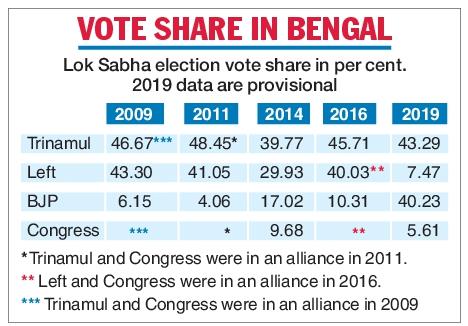
BJP in 2019 looks like TMC of 2009
 DEVADEEP PUROHIT, TT, 24 May 2019, Calcutta: The Lok Sabha poll outcome in Bengal suggests polarisation of voters along religious lines has benefited both Mamata Banerjee and Narendra Modi but the BJP has emerged as the bigger beneficiary.
DEVADEEP PUROHIT, TT, 24 May 2019, Calcutta: The Lok Sabha poll outcome in Bengal suggests polarisation of voters along religious lines has benefited both Mamata Banerjee and Narendra Modi but the BJP has emerged as the bigger beneficiary.Around Thursday night, the BJP had either won or was leading in 18 seats in Bengal, snapping at the heels of Trinamul (22), reducing the Congress (2) to a bit player and demolishing the Left (0) in an astonishing performance in the state where it was once dismissed as a north Indian party.
Consider the figures: The BJP now has the support of over 2.17 crore people (or over 40 per cent of the electorate) in Bengal. The BJP is breathing down the neck of Trinamul which has just 17 lakh more supporters than Modi's party. This means the gap between Mamata's Trinamul and Modi's BJP is just 3 per cent. In an ominous sign for Trinamul, the BJP has surged ahead in 16 out of the 18 seats in rural Bengal, which used to be Mamata's fief since the change of guard in 2011. Most of Trinamul's welfare schemes were targeted at the rural population. If the Lok Sabha results are broken down, it shows that Trinamul is ahead only in 150plus Assembly segments while the BJP is ahead in 130. In the 294-seat Bengal Assembly, the halfway mark is 148.
How did the BJP, whose organisational weaknesses in Bengal are well known, pull off such a performance? An oversimplified answer would be driven by basic arithmetic: as the Left's vote share slide of over 22 per cent is almost equal to the BJP's vote share gain, you don't have to look far to spot the weak link. But why did the so-called Left voter shun the "secular alternatives" and flock to the BJP? Preliminary indications suggest polarisation, an explosion of pent-up anger over Trinamul excesses during the panchayat polls last year and a backlash at highhandedness by satraps, given to making extortion-scale demands, might have played a role in cracking open Bengal for the BJP.
The BJP's narrative -- that Modi harped on at the 16 meetings he addressed in the state -- appears to have more than compensated for the organisational deficiencies.
The election results suggest that when Modi reminded his audience of the Pulwama attack and the Balakot reply or pledged an Assam-like National Register of Citizens to weed out infiltrators or complained about problems in organising Durga Puja or Saraswati Puja, it appeared to have made a mark on Hindu voters from all camps and castes.
That explains the spike in the BJP's vote share from about 17 per cent in 2014 to over 40 per cent this time. The fact that the BJP is ahead in seats like Alipurduar and Jhargram (reserved for Scheduled Tribe candidates) and Bankura and Purulia (which have a high concentration of tribal voters) prove that Modi's narrative has struck a chord with the socially backward sections in Bengal.
The BJP's success in bagging all the eight seats in north Bengal -- besides Bongaon and Ranaghat, which have a high Matua concentration -- is another indication that the NRC pledge helped in Hindu consolidation although Trinamul tried its best to explain to people that the exercise would result in hardships for Hindus and Muslims alike.
The issues that Modi and Amit Shah raised had an impact on Trinamul too. Mamata, too, benefited in terms of the consolidation of around 30 per cent Muslim votes as fear ruled the minds of the community and Trinamul seemed the only safe bet for the majority of minority voters.
That gain is reflected in terms of Trinamul's higher vote share in comparison to the last Lok Sabha polls, but it was limited only to South Bengal seats with high minority concentration like Basirhat, Diamond Harbour, Barasat or Uluberia.

0 Response to "BJP in 2019 looks like TMC of 2009 "
Post a Comment
Disclaimer Note:
The views expressed in the articles published here are solely those of the author and do not necessarily reflect the official policy, position, or perspective of Kalimpong News or KalimNews. Kalimpong News and KalimNews disclaim all liability for the published or posted articles, news, and information and assume no responsibility for the accuracy or validity of the content.
Kalimpong News is a non-profit online news platform managed by KalimNews and operated under the Kalimpong Press Club.
Comment Policy:
We encourage respectful and constructive discussions. Please ensure decency while commenting and register with your email ID to participate.
Note: only a member of this blog may post a comment.